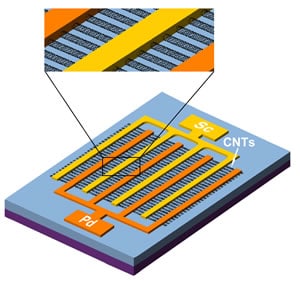
In comparison to traditional infrared detectors, which are based on semiconductors made of a mercury-cadmium-telluride alloy, the SWNTs are more efficient, and the detector demonstrated “acceptable sensitivity” at room temperature.
The new design eliminates liquid nitrogen or electric cooling because carbon nanotubes have special thermal properties. At room temperature, they emit comparatively little infrared radiation of their own, especially when the carbon nanotube is on the substrate. In addition, nanotubes are very good at conducting heat, so temperatures do not build up on the detector itself.
The next step for the team is to focus on improving the detectivity of the detector with greater SWNT density and to also achieve a wide spectrum response with improved diameter control.






